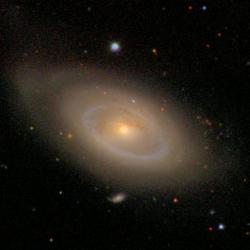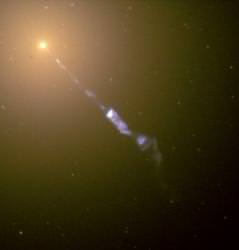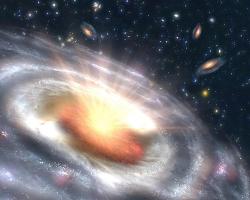According to new research, a galaxy with a quasar in the middle is not a good place to grow up. As active galactic nuclei (AGN) evolve, they pass through a “quasar phase”, where the accretion disk surrounding the central black hole blasts intense radiation into space. The quasar far outshines the entire host galaxy. After the quasar phase, when the party is over, it is as if there is no energy left and star formation stops.
AGN are the compact, active and bright central cores to active galaxies. The intense brightness from these active galactic cores is produced by the gravitationally driven accretion disk of hot matter spinning and falling into a supermassive black hole at the centre. During the lifetime of an AGN, the black hole/accretion disk combo will undergo a “quasar phase” where intense radiation is blasted from the superheated gases surrounding the black hole. Typically quasars are formed in young galaxies.

Although the quasar phase is highly energetic and tied with young galaxy formation, according to new results from the Sloan Digital Sky Survey, it also marks the end for any further star birth in the galaxy. These findings will be presented today (Friday 4th April) at the RAS National Astronomy Meeting in Belfast, Northern Ireland, by Paul Westoby having just completed a study of 360 000 galaxies in the local Universe. He carried out this research with Carole Mundell and Ivan Baldry from the Astrophysics Research Institute of Liverpool, John Moores University, UK. This study was proposed to understand the relationship between accreting black holes, the birth of stars in galactic cores and the evolution of galaxies as a whole. The results are astonishingly detailed.
By analysing so many galaxies, quite a detailed picture emerges. The primary result to come from this shows that as a young galactic core is dominated by a highly energetic quasar, star formation stops. After this phase in a galaxy’s life, star formation is not possible; the remaining stars are left to evolve by themselves.
It is believed that all AGNs go through the quasar phase in their early galactic lives. It is also thought that most massive galaxies will have a supermassive black hole hiding inside their galactic cores passively, having already gone through the quasar phase. Westoby notes that some dormant supermassive black holes can be “reignited” into a secondary quasar phase, but the mechanisms behind this are sketchy.
“The starlight from the host galaxy can tell us much about how the galaxy has evolved […] Galaxies can be grouped into two simple colour families: the blue sequence, which are young, hotbeds of star-formation and the red sequence, which are massive, cool and passively evolving..” – Paul Westoby.
It is found there is a sudden cut-off point for star formation, and this occurs right after the quasar phase. After the quasar phase, the AGN relaxes into a quieter state, there is no star formation and gradual evolution of stars progresses into the “red sequence” of star evolution.
Other findings include the indication that regardless of the size of the galaxy, it is the shape of the galactic “bulge” that matters. Without a large classical bulge in the centre, supermassive black holes that drive the AGN are not possible. Therefore, only galaxies with a bulge have AGN at the core. Another factor affecting supermassive black hole formation is the density of galaxies in a volume of space. Should there be too many, supermassive black holes become a scarcity.



“Without a large classical bulge in the centre, supermassive black holes that drive the AGN are not possible.”
That’s an oversimplification. The dwarf Seyfert NGC 4395 has a BH, but no bulge, and other likely examples are known. Maybe they mean that central BHs don’t get “supermassive” unless you have a large classical bulge.
I would have thought it was the other way round – you can’t have a large bulge unless you have a super-massive black hole.
It isn’t necessarily true that star formation is over right after the quasar phase. When two galaxies interact gravitational, giant tidal tails of gas and dust will trail out from one or more of the galaxies involved, and these are often seen to be replete with star formation. Another case in which runaway generalizations can lead to misunderstandings.
It would seem that there could be several misconceptions here, probably of the author. The information can make sense is interpreted right.
It makes sense a quasar could blow out the gas and dust away from the galaxy, cleaning house and eliminating the raw materials necessary for the creation of new stars. However, there are still old stars there and if the quasar phase lasts a shorter time than the lifetime of supermassive stars – a few million years, then there will be those large stars that go supernova, and smaller stars that ejected planetary nebulae and solar wind particles from most all stars that will reseed the galaxy with star froming material.
It’s then probable that the material will gravitationally clump and be pushed this way and that by additional supernovae and reestablish star formation, at least in the disk of the spiral galaxy.
Note that the milky way – our galaxy has about a 3.7million solar mass BH. It has globular clusters in the halo that appear to be about 10 billion years old and should have had this AGN quasar period. Yet, we see the sun as about 5 billion years old and we see plenty of galactic smog (gas and dust) and we obviously see ongoing star formation, from some in the first phases to the existance of very high massive stars that have lifetimes far shorter than the time since the dinosaurs went extinct.
All of this local evidence refutes the basic notions of the article unless one adds the notion that the stars are reseeding the galaxay and forcing the return of star formation. You’ll note the sun is not a first generation star nor probably even a second or third generation one. The material the sun formed from was ejected by earlier stars.
Since ellipticals evidently contain similar sized supermassive BHs and have no modern star formation (and no significan amount of interstellar dust and gas (and the same goes for globular clusters), it is possible that AGN and quasars could have gone on inside there too and that perhaps there were not sufficient numbers of very massive stars present to reseed – or perhaps the density of stars was so high in these that forming conditions could no longer exist after the first stars were created – or perhaps that the AGN / quasar phase happened shortly after the very massive stars went supernova.
From the ancestral time the world space research established on blind theory. We although demand that we have discovered lots of mysteries viz. milk ways, galaxies, nebulas, white drafts, black holes etcs., in real they are creation of space mirror. SPACE MIRROR is the truth and hidden mystery of the space. Since we are unknown about space mirror, our research has diverted from original truth and we have spent lots of time and money behind the false truth.
Therefore it invites you to visit http://www.spacemirrormystery.com and if you find the relevancy in contains of the web please make the news items for prosperous space research.
Noe we are fascinated by quasar.